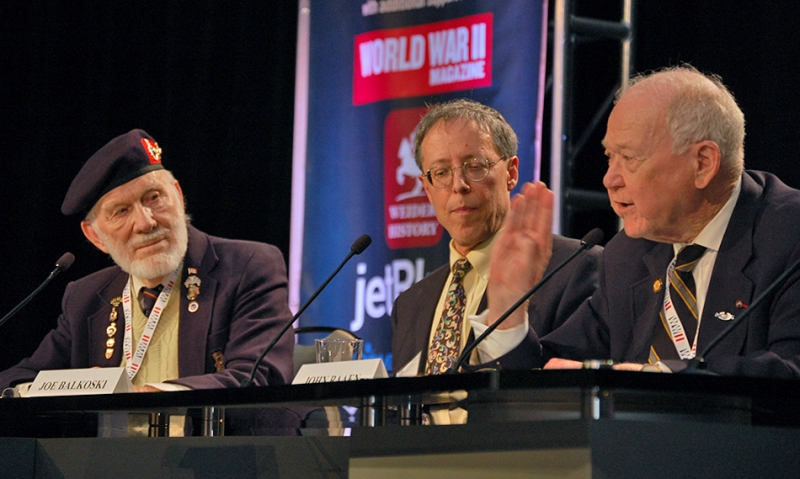
Top historians offer insights about conflicts worldwide in 1944 that led to the end of the Axis.
The planet was embroiled in 1944. The D-Day invasion into Normandy, France, on June 6 of that year was just one episode in a global theater of deadly warfare that ultimately led to victory by western Allies over Axis powers. In addition to Operation Overlord, there was Anzio, Saipan and Warsaw, along with dozens of other hotspots around the globe. The most massive air campaign in human history occurred three months before American, British and Canadian forces stormed the beaches of northern France. There were technological breakthroughs, spies, double spies and battles of egos.
Some of the world's most renowned scholars and writers about World War II gathered in New Orleans Friday to examine the mosaic of events – many of which were overshadowed by D-Day – which contributed to the year that turned the tide in the Second World War.
The 2014 International Conference on WWII continues through the weekend and is streamed live online by the National World War II Museum here. www.ww2conference.com.
"The outcome, it seems to me, was predictable," historian and author Dr. Robert Citino said during his discussion of Soviet breakthrough of the German line on the eastern front that occurred two weeks after D-Day. "It peeled open a 250-mile gap. The Soviets were giving the Germans a large thumping in the summer of 1944."
The German wehrmarcht began to panic as U.S., British and Canadian forces were rolling their tanks, jeeps, trucks, troops and artillery ashore in France, Citino said. At the same time, the Soviets were squeezing in on Germany from the eastern side. "It hit like a thunderbolt," the scholar explained of the Soviet penetration of the German eastern line, Operation Bagration.
The western Allies were on their way east toward Berlin. The Soviets, who had suffered millions of losses at the hands of the Germans earlier in the war, were on their way west, exacting what was described at the conference as "Stalin's revenge." Allied air forces, reinvigorated by the arrival of the new P-51 that could outperform the Luftwaffe in numerous ways, were finally achieving an advantage after months of stalemate in the skies. From the south, definitive Allied victory in Italy meant that defeat was imminent for the stubbornly insane Adolf Hitler and his doomed Third Reich.
Scholars like Dr. Alexandra Richie of Poland were at the conference to share the horrific story of the Warsaw Uprising. More than 200,000 Polish civilians were killed in the 1944 resistance to Germany's attempt to secure Poland from the fast-advancing Soviet military after Operation Bagration and the attempt to assassinate Hitler. She described Poland as a nation "caught between two dictatorships."
As the Soviet advance stalled about 20 kilometers from Warsaw, Hitler ordered that every inhabitant and all structures in the city be destroyed. "These were enormous atrocities," Richie told nearly 1,000 attendees of the conference. "They were vicious, terrible battles that are forgotten now."
Meanwhile in the Pacific Theater, U.S. Marines, sailors and soldiers were establishing the biggest strategic air base in the theater. U.S. Marine divisions, an Army division and the Navy struggled through command conflicts – personalities at the top of the chain – to ultimately take Saipan and control the strategically located Marianas. More than 9,000 Americans gave their lives in the battle which is too often overlooked in history.
"It deserves much more attention," author James Hornfischer said of Operation Forager, which was executed less than two weeks after D-Day. "That's one reason I am working on my current project." Hornfischer is the author of three acclaimed books on World War II naval history.
Dr. Douglas Porch gave the Gen. Raymond E. Mason Jr. Distinguished Lecture on WWII that explored the importance of French involvement in the removal of German forces from Italy in 1944. "The Mediterranean was vital," he told the crowd. "It was literally the path to victory."
Friday's session showed that there was not just one path. For D-Day veteran Maj. Gen. John Raaen, who was a captain in the 5th Ranger Battalion during the Normandy invasion, the path was a strip of Omaha Beach that was not his unit's intended target. Waved off twice, his landing craft finally landed the morning of D-Day and used breakwater retards to protect themselves from enemy fire, which reduced their casualties to just a few men. "Within 20 minutes, our companies were already attacking the bluffs," he said. "Most units crossed and were slaughtered. We got across with less than 1 percent of casualties."
Richard Sadler, who fought with the Royal Marines, was on one of three British landing crafts that hit Juno Beach on D-Day. He shared his experience coming ashore with Canadian forces who delivered the first tanks to Normandy on D-Day and how his craft nearly sank that morning. "I looked around and realized, ‘I can't bloody swim,’" he told the crowd. He survived the initial landing to help ferry equipment and troops back and forth across the channel, delivering the troops and equipment necessary to make the victorious march to Berlin over the next 11 months.
Friday's session illustrated that it was indeed a world war, one with many paths to victory, from the beaches of Normandy to the skies over Berlin to the Mariana Islands. How it all came together in 1944 and began the long, deadly process of erasing the Axis is the subject of the conference, the fourth of which that honors the 70th anniversary of the war that changed the course of human civilization.
- Honor & Remembrance

